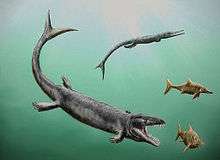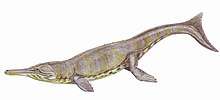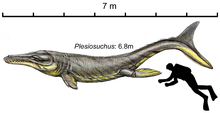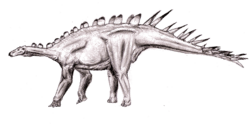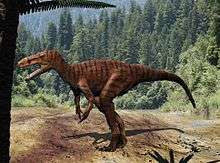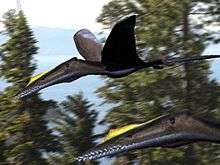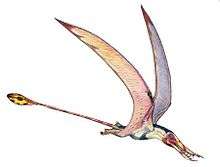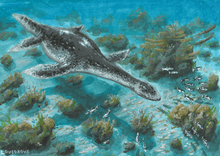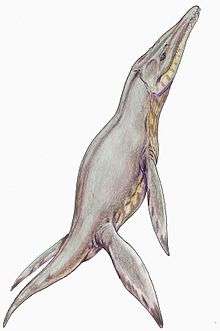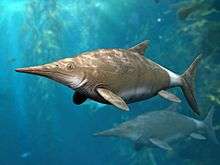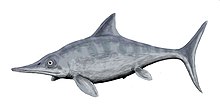Kimmeridge Clay
The Kimmeridge Clay is a sedimentary deposit of fossiliferous marine clay which is of Late Jurassic to lowermost Cretaceous age and occurs in southern and eastern England and in the North Sea.[1] This rock formation is the major source rock for North Sea oil. The fossil fauna of the Kimmeridge Clay includes turtles, crocodiles, sauropods, plesiosaurs, pliosaurs and ichthyosaurs, as well as a number of invertebrate species.
| Kimmeridge Clay Stratigraphic range: Kimmeridgian–Berriasian | |
|---|---|
 Grey cliffs of Upper Kimmeridge Clay above the beach at Egmont Bight | |
| Type | Geological formation |
| Unit of | Ancholme Group (onshore), Humber Group (offshore) |
| Sub-units | Birch Sandstone Member, Burns Sandstone Member, Claymore Sandstone Member, Dirk Sandstone Member, Magnus Sandstone Member, Ptarmigan Sandstone Member, Ribble Sandstone Member |
| Underlies | Portland Sand Formation, Speeton Clay Formation, Spilsby Sandstone |
| Overlies | Ampthill Clay, Corallian Group |
| Lithology | |
| Primary | Mudstone |
| Other | Siltstone, Sandstone, Conglomerate |
| Location | |
| Region | England (surface) North Sea (subsurface) |
| Country | United Kingdom |
| Type section | |
| Named for | Kimmeridge Bay |
| Location | Type area - coastal outcrops from Black Head, Weymouth to Chapmans Pool |
Description
Kimmeridge Clay is named after the village of Kimmeridge on the Dorset coast of England, where it is well exposed and forms part of the Jurassic Coast World Heritage Site.[2] Onshore, it is of Late Jurassic (Kimmeridgian) age and outcrops across England, in a band stretching from Dorset in the south-west, north-east to North Yorkshire. Offshore, it extends into the Lower Cretaceous (Berriasian Stage) and it is found throughout the Southern, Central and Northern North Sea.[1]
The foundations of the Humber Bridge on the southern (Barton) side of the bridge are on Kimmeridge Clay beneath superficial deposits, under the Humber estuary.[3]
Economic importance
Kimmeridge Clay is of great economic importance,[2] being the major source rock for oil fields in the North Sea hydrocarbon province.[4] It has distinctive physical properties and log responses.[5]
A Kimmeridge Oil Shale Project (KOSP) has been pursued by the UK-based oil and shale gas exploration company Cuadrilla Resources.[6]:6
Vertebrate fauna
Color key
|
Notes Uncertain or tentative taxa are in small text; |
Fauna uncovered from the Kimmeridge Clay include:[7]
Ray-finned fish
| Ray-finned fishes of the Kimmeridge clay Formation | ||||||
|---|---|---|---|---|---|---|
| Genus | Species | Location | Stratigraphic Position | Abundance | Notes | Images |
|
Indeterminate |
Dorset |
Most common Kimmeridge clay fish, known from several complete specimens |
Housed at the etches collection, discovered by Steve Etches |
 Complete specimen | ||
|
Indeterminate |
Dorset |
Housed at the etches collection, discovered by Steve Etches |
||||
|
Indeterminate |
Dorset |
Housed at the etches collection, discovered by Steve Etches |
||||
|
Indeterminate |
Dorset |
One specimen, a fin |
Housed at the etches collection, discovered by Steve Etches |
|||
|
Indeterminate |
Dorset |
Housed at the etches collection, discovered by Steve Etches |
||||
|
Indeterminate |
Dorset |
Housed at the etches collection, discovered by Steve Etches |
||||
|
Indeterminate |
Dorset |
Housed at the etches collection, discovered by Steve Etches |
||||
|
Indeterminate |
Dorset |
Housed at the etches collection, discovered by Steve Etches |
||||
|
H.tenuirostris |
Dorset |
Rare |
Housed at the etches collection, discovered by Steve Etches |
|||
|
Indeterminate |
Dorset |
Rare |
Housed at the etches collection, discovered by Steve Etches |
|||
|
Indeterminate |
Dorset |
Rare, one complete specimen |
Housed at the etches collection, discovered by Steve Etches |
|||
|
Indeterminate |
Dorset |
Fairly common, multiple near complete specimens. |
Housed at the etches collection, discovered by Steve Etches |
|||
Lobe-finned fish
| Lobe-finned fishes of the Kimmeridge clay Formation | ||||||
|---|---|---|---|---|---|---|
| Genus | Species | Location | Stratigraphic Position | Abundance | Notes | Images |
|
Indeterminate |
Dorset |
One specimen, cranial material |
Housed at the etches collection, discovered by Steve Etches. More than 2 metres long |
|||
|
Indeterminate |
Dorset |
One specimen, a portion of the head |
Housed at the etches collection, discovered by Steve Etches |
|||
Cartilaginous fish
| Cartilaginous fishes of the Kimmeridge clay Formation | ||||||
|---|---|---|---|---|---|---|
| Genus | Species | Location | Stratigraphic Position | Abundance | Notes | Images |
|
Indeterminate |
Dorset |
Known from many dorsal spines |
Housed at the etches collection, discovered by Steve Etches |
|||
|
Indeterminate |
Dorset |
Known from many dorsal spines |
Housed at the etches collection, discovered by Steve Etches |
|||
|
Indeterminate |
Dorset |
Known from many dorsal spines, perhaps a complete head |
Housed at the etches collection, discovered by Steve Etches |
|||
|
Indeterminate |
Dorset |
One specimen |
Housed at the etches collection, discovered by Steve Etches |
|||
|
Indeterminate |
Dorset |
Known from a complete specimen, and other isolated remains |
Housed at the etches collection, discovered by Steve Etches |
|||
Archosaurs
Thalattosuchians
| Genus | Species | Location | Member | Abundance | Notes | Images |
|---|---|---|---|---|---|---|
|
B. megarhinus |
A pelagic teleosaurid.[10] |
|||||
|
C. gracilis |
||||||
|
D. maximus |
A geosaurine metriorhynchid | |||||
|
M. geoffreyi |
A metriorhynchine metriorhynchid | |||||
|
P. manseli |
A geosaurine metriorhynchid | |||||
|
T. carpenteri[11] |
A geosaurine metriorhynchid | |||||
|
T. coryphaeus[13] |
A geosaurine metriorhynchid | |||||
Ornithischians
Indeterminate ankylosaur osteoderms have been found in Wiltshire, England.[14] Indeterminate stegosaurid remains have been found in Dorset and Wiltshire, England.[7]
| Genus | Species | Location | Member | Abundance | Notes | Images |
|---|---|---|---|---|---|---|
|
C. prestwichii[7] |
|
"Fragmentary skull and skeleton."[15] |
||||
|
D. armatus[7] |
Wiltshire remains include specimens previously referred to Omosaurus armatus and O. hastiger.[7] | |||||
|
Indeterminate[7] |
|
Kimmeridge clay remains considered to represent a possible close relative of Bugenasaura[16] are now regarded as the remains of an indeterminate euornithopod.[7](The specimen may have had its locality and horizon mislabelled.) | ||||
|
O.armatus[7] |
|
Reclassified as Dacentrurus armatus because the generic name Omosaurus was preoccupied.[7] | ||||
|
O. hastiger[7] |
|
|||||
Saurischians
Indeterminate ornithomimmid remains have been found in Dorset, England.[7] An undescribed theropod genus was found in Dorset.[7]
| Genus | Species | Location | Stratigraphic position | Material | Notes | Images |
|---|---|---|---|---|---|---|
|
B. suffosus[7] |
|
"[Seven] dorsal and sacral centra."[17] |
| |||
|
C. humerocristatus[7] |
|
Now Duriatitan.[18] | ||||
|
Indeterminate[7] |
|
Remains previously referred to an indeterminate species of Cetiosaurus are now regarded as indeterminate sauropod material.[7] | ||||
|
D. humerocristatus |
|
|||||
|
G. megalonyx[7] |
|
Remains previously referred to Gigantosaurus megalonyx are now regarded as indeterminate sauropod material.[7] | ||||
|
I. manseli[7] |
|
"Humerus."[20] |
Remains previously referred to Ischyrosaurus manseli are now regarded as indeterminate sauropod material.[7] | |||
|
J. langhami |
|
Partial skeleton |
A primitive tyrannosaur | |||
|
Indeterminate |
Remains previously referred to Megalosaurus are now regarded as indeterminate theropod material.[7] | |||||
|
Indeterminate[7] |
Remains previously attributed to one or more indeterminate species of Ornithopsis (incl. O. leedsii) are now regarded as possible indeterminate sauropod material.[7] | |||||
Pterosaurs
| Genus | Species | location | Material | Notes | Images |
|---|---|---|---|---|---|
| Cuspicephalus[23] | C. scarfi |
Dorset |
Partial Skull | Missing Crest, lower jaw and dentition |
|
|
R.etchesi |
Dorset |
||||
|
indeterminate |
Dorset |
||||
Plesiosaurs
| Genus | Species | Location | Member | Abundance | Notes | Images |
|---|---|---|---|---|---|---|
|
B. swindoniensis |
Plesiosaur of unknown affinities |
| ||||
|
C. megadeirus |
||||||
|
C. trochantericus |
Nomen dubium | |||||
|
K. langhami |
A cryptoclidid | |||||
|
"P." manseli |
Distinct from Colymbosaurus.[24] | |||||
|
P. brachydeirus |
||||||
| P. brachyspondylus | ||||||
|
P. carpenteri |
A thalassophonean pliosaurid | |||||
|
P. kevani |
A thalassophonean pliosaurid | |||||
|
P. portentificus[27] |
A thalassophonean pliosaurid | |||||
|
P. ?rossicus |
A thalassophonean pliosaurid; taxonomic identification of specimens tentative[25] | |||||
|
P. westburyensis |
A thalassophonean pliosaurid | |||||
|
P. sp. 1 |
Partial skeleton, CAMSM J.35991 |
A thalassophonean pliosaurid; previously assigned to the nomen dubium P. brachyspondylus[25][26] | ||||
|
P. sp. 2 |
Mandible, NHMUK PV OR 39362 |
A thalassophonean pliosaurid; previously assigned to the nomen dubium P. macromerus[25][26] | ||||
|
Indeterminate |
||||||
Ichthyosaurs
| Ray-finned fishes of the Kimmeridge clay Formation | ||||||
|---|---|---|---|---|---|---|
| Genus | Species | Location | Stratigraphic Position | Abundance | Notes | Images |
|
B.extremus |
Dorset |
|||||
|
G.mordax |
Dorset |
|||||
|
Indeterminate |
Dorset |
Giant, near complete specimen. Proposed to have been 6 metres long when complete. Housed at the Etches collection in dorset. | ||||
|
M.trigonus |
Dorset |
Nomen dubium - classified by a single vertebra | ||||
|
N.enthekiodon |
Dorset |
|||||
|
Indeterminate |
Dorset |
|||||
Invertebrates
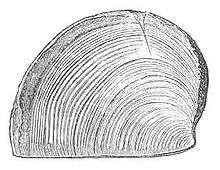
The invertebrate fauna of the Kimmeridge Clay includes:[28][29]
- Mollusca:
- Cardium striatulum
- Ostrea deltoidea
- Gryphaea (Exogyra) virgula
- Trigonellites
- Belemnotheutis
- Arthropoda:
- Phlyctosoma sp.
- Eryma sp.
- Magitalatimana sp.
- Mechochirus sp.
- Archaeolepas redtenbacheri
See also
- List of dinosaur-bearing rock formations
References
- British Geological Survey. "Kimmeridge Clay Formation". BGS Lexicon of Named Rock Units. Retrieved 2 November 2018.
- Gallois R.W. (2004). "The Kimmeridge Clay: the most intensively studied formation in Britain". Open University Geological Journal. 25 (2).
- Historic England. "The Humber Bridge (1447321)". National Heritage List for England. Retrieved 2 November 2018.
- Gautier D.L. (2005). "Kimmeridgian Shales Total Petroleum System of the North Sea Graben Province" (PDF). United States Geological Survey. Retrieved 2 November 2018.
- Penn I.M.; Cox B.M.; Gallois R.W. (2007). "Towards precision in stratigraphy: geophysical log correlation". In Gregory F.J.; Copestake P.; Pearce J.M. (eds.). Key Issues in Petroleum Geology: Stratigraphy. Geological Society, London. pp. 34–35. ISBN 9781862392373.
- Andy Lukas (17 July 2013). "Approaches to informed and balanced debate about shale gas in the UK – How we are working with the Communities" (PDF). Fracking and our Gas Future. AJ Lucas Group Ltd. p. 45. Retrieved 18 May 2016.
- Weishampel, David B; et al. (2004). "Dinosaur distribution (Late Jurassic, Europe)." In: Weishampel, David B.; Dodson, Peter; and Osmólska, Halszka (eds.): The Dinosauria, 2nd, Berkeley: University of California Press. Pp. 545–549. ISBN 0-520-24209-2.
- Etches, S, Clarke, J. (2010). Life in Jurassic seas. Dorset, Dorchester: Epic Creative Print.
- http://www.theetchescollection.org/collections Retrieved 31/10/2017
- Foffa, D.; Johnson, M.M.; Young, M.T.; Steel, L.; Brusatte, S.L. (2019). "Revision of the Late Jurassic deep-water teleosauroid crocodylomorph Teleosaurus megarhinus Hulke, 1871 and evidence of pelagic adaptations in Teleosauroidea". PeerJ. 7: e6646. doi:10.7717/peerj.6646. PMC 6450380. PMID 30972249.
- Wilkinson, L.E.; Young, M.T.; Benton, M.J. (2008). "A new metriorhynchid crocodilian (Mesoeucrocodylia: Thalattosuchia) from the Kimmeridgian (Upper Jurassic) of Wiltshire, UK". Palaeontology. 51 (6): 1307–1333. doi:10.1111/j.1475-4983.2008.00818.x.
- Andrade, M.B.D.; Young, M.T.; Desojo, J.B.; Brusatte, S.L. (2010). "The evolution of extreme hypercarnivory in Metriorhynchidae (Mesoeucrocodylia: Thalattosuchia) based on evidence from microscopic denticle morphology". Journal of Vertebrate Paleontology. 30 (5): 1451–1465. doi:10.1080/02724634.2010.501442.
- Mark T. Young; Marco Brandalise De Andrade; Steve Etches; Brian L. Beatty (2013). "A new metriorhynchid crocodylomorph from the Lower Kimmeridge Clay Formation (Late Jurassic) of England, with implications for the evolution of dermatocranium ornamentation in Geosaurini". Zoological Journal of the Linnean Society. 169 (4): 820–848. doi:10.1111/zoj.12082.
- Martill, D.M.; Naish, D.; Earland, S. (2006). "Dinosaurs in marine strata: evidence from the British Jurassic, including a review of the allochthonous vertebrate assemblage from the marine Kimmeridge Clay Formation (Upper Jurassic) of Great Britain.". Colectivo Arqueológico y Paleontológico Salense (PDF) (Actas de las III Jornadas Internacionales sobre Paleontología de Dinosaurios y su Entorno, 16–17 Sep. 2004. Salas de los Infantes, Burgos, España ed.). pp. 47–84.
- "Table 19.1," in Weishampel, et al. (2004). Page 415.
- Galton, Peter M. (1999). "Cranial anatomy of the hypsilophodont dinosaur Bugenasaura infernalis (Ornithischia: Ornithopoda) from the Upper Cretaceous of North America". Revue Paléobiologie, Genève. 18 (2): 517–534.
- "Table 13.1," in Weishampel, et al. (2004). Page 270.
- Paul M. Barrett; Roger B.J. Benson; Paul Upchurch (2010). "Dinosaurs of Dorset: Part II, the sauropod dinosaurs (Saurischia, Sauropoda) with additional comments on the theropods". Proceedings of the Dorset Natural History and Archaeological Society. 131: 113–126.
- "Table 13.1," in Weishampel, et al. (2004). Page 267.
- "Table 13.1," in Weishampel, et al. (2004). Page 271.
- Benson, R.B.J. (2008). "New information on Stokesosaurus, a tyrannosauroid (Dinosauria: Theropoda) from North America and the United Kingdom". Journal of Vertebrate Paleontology. 28 (3): 732–750. doi:10.1671/0272-4634(2008)28[732:NIOSAT]2.0.CO;2.
- Brusatte, S.L.; Benson, R.B.J. (2013). "The systematics of Late Jurassic tyrannosauroids (Dinosauria: Theropoda) from Europe and North America". Acta Palaeontologica Polonica. 58 (1): 47–54. doi:10.4202/app.2011.0141.
- "A new monofenestratan pterosaur from the Kimmeridge Clay Formation (Kimmeridgian, Upper Jurassic) of Dorset, England - Acta Palaeontologica Polonica". www.app.pan.pl. Retrieved 2017-08-31.
- Benson, RBJ; Bowdler, T (2014). "Anatomy of Colymbosaurus (Reptilia, Plesiosauria) from the Kimmeridge Clay Formation of the U.K., and high diversity among Late Jurassic plesiosauroids". Journal of Vertebrate Paleontology. 34 (5): 1053–1071. doi:10.1080/02724634.2014.850087.
- Roger B. J. Benson, Mark Evans, Adam S. Smith, Judyth Sassoon, Scott Moore-Faye, Hilary F. Ketchum and Richard Forrest (2013). "A Giant Pliosaurid Skull from the Late Jurassic of England". PLoS ONE. 8 (5): e65989. doi:10.1371/journal.pone.0065989. PMC 3669260. PMID 23741520.CS1 maint: uses authors parameter (link)
- Espen M. Knutsen (2012). "A taxonomic revision of the genus Pliosaurus (Owen, 1841a) Owen, 1841b". Norwegian Journal of Geology. 92 (2–3): 259–276. ISSN 0029-196X.CS1 maint: uses authors parameter (link) Low resolution pdf Archived 2013-12-24 at the Wayback Machine High resolution pdf Archived 2013-12-24 at the Wayback Machine
- Noè, L. F.; Smith, D. T. J.; Walton, D. I. (2004). "A new species of Kimmeridgian pliosaur (Reptilia; Sauropterygia) and its bearing on the nomenclature of Liopleurodon macromerus". Proceedings of the Geologists' Association. 115: 13–24. doi:10.1016/S0016-7878(04)80031-2.
- http://www.fullbooks.com/The-Student-s-Elements-of-Geology7.html The Student's Elements of Geology by Sir Charles Lyell Part 7 out of 14 accessed 13 February 2009.
- Wignall, Paul B. (1990). "Benthic palaeoecology of the late Jurassic Kimmeridge Clay of England" (PDF). Special Papers in Palaeontology. The Palaeontological Association, London. 43. ISBN 978-0-901702-42-5. Archived from the original (PDF) on August 26, 2011. Retrieved February 8, 2011.
Bibliography
- Galton, P.M. 1999. Cranial anatomy of the hypsilophodontid dinosaur Bugenasaura infernalis (Ornithischia: Ornithopoda) from the Upper Cretaceous of North America. Revue Pale´obiologie, 18, 517–534.
Further reading
- Martill, D.M., Naish, D. & Earland, S. 2006. Dinosaurs in marine strata: evidence from the British Jurassic, including a review of the allochthonous vertebrate assemblage from the marine Kimmeridge Clay Formation (Upper Jurassic) of Great Britain. In: Colectivo Arqueologico y Paleontologico Salense, (ed.) Actas de las III Jornadas Intrernacionales sobre Paleontologı´a de Dinosaurios y su Entorno, 16–17 September 2004. Salas de los Infantes, Burgos, 47–84.

